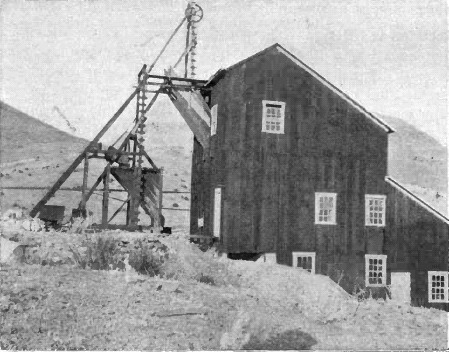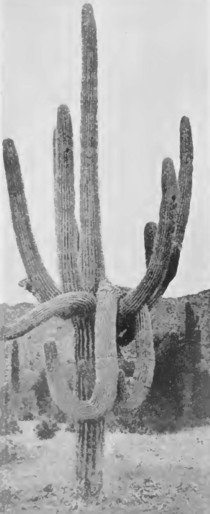The first mineral discoveries were made in what is now Pinal county in the fall of 1871, but the hostility of the Indians and the isolated condition of the Territory at that time prevented any real development. The region was known to be rich in the precious metals, and after a peace was conquered from the Apaches, in 1874, prospectors flocked thither. The discovery of the famous Silver King in the fall of 1874, was the beginning of permanent mining in Pinal, and since that time it has been prosecuted without intermission and with the most flattering results. Few counties of the Territory can show a better record of bullion production. The Gila river, which flows through the center of this mineral belt, affords an unlimited water supply; while wood is found everywhere sufficient for all purposes of ore reduction. The ore bodies of Pinal county are noticeable for their size and richness. The formation of the country rock varies according to the locality, but granite and porphyry appear to be the predominating formations. A basalt out cropping is found in some places, and quartzite is sometimes met with. Gold, silver, and copper are the leading metals of Pinal. Large bodies of coal of an excellent quality, have lately been discovered in the eastern portion of the county. A railroad has been surveyed from Casa Grande to Pinal City which will pierce the center of the mining region, and will be of incalculable benefit to the county. In its bullion product at the present time, Pinal takes the second place among the counties of the Territory; and with the opening of the projected rail communication, we may look to see that production largely increased.
Pioneer District.—The Silver King, the leading mine of Pinal, is situated in this district. The croppings of the vein are on a low, conical hill, in a basin, surrounded by spurs of the Pinal mountains. It is said that the mine was discovered from information furnished by a discharged soldier, who was stationed at this point during the Apache wars. After working the mine for nearly two years and taking thousands of dollars from surface excavations, the original locators sold the property to the present company, and the work of development was begun systematically. The discoverers of this magnificent property— farmers in the Gila valley— built better than they knew " when they conferred so appropriate a name on the wonderful mine. The vein matter is chiefly quartz; the ore is a sulfide, carrying large quantities of native silver, polybasite, cuprite, sphalerite, tetrahedrite, and other combinations.
No such bodies of native silver have been found on the coast. The main working shaft is down over 600 feet, showing fine ore in the bottom; five levels have been run, and cross-cuts and winzes have thoroughly opened the mine. In places the ore body is 85 feet wide. A twenty-stamp mill has been put up at Pinal, five miles distant, and also a roaster and concentration works. The yield of bullion for May, 1881, amounted to $99,000. The ores are worked by the lixiviation process, which has proven a complete success. Whether we consider the size of the vein, the richness and variety of its ores, or its bullion yield, the King must be ranked as one of the great mines of the world.
The North King has a shaft 450 feet in depth, with improved hoisting machinery. The South King has been sunk to a depth of 150 feet. The property is owned by San Francisco parties. The Eastland is down 200 feet, and work is prosecuted steadily. This mine is producing some fine ore. Hoisting-works have been erected. The Last Chance shows a vein nearly 5 feet in width. The ore is a sulfide, rich in silver ore. There is a tunnel on the claim 160 feet in length. The Mount View has a 4-foot vein of argentiferous galena ore. It is opened by a shaft 100 feet in depth. The Alice Bell shows 4 feet of galena ore, carrying considerable silver. It has a tunnel 80 feet.
The Belcher is one of the leading mines of the district. It is a horn silver chloride ore which gives an average of $82 per ton, the vein being from 3 to 5 feet wide. A ten-stamp mill has been erected on the property. The Eureka is on the same ledge as the Belcher. It shows a vein of chloride ore from 2 to 3 feet wide, assaying $100 per ton. It has produced about $5,000. The Surprise is a large ledge of gold ore, 8 feet wide, assaying $40 per ton. It is owned by the Surprise Mining Company, who intend to erect a twenty-stamp mill the present year. The Gem is a 5-foot ledge of gold quartz. A mill has recently been erected on the property, which is owned by the Wide Awake Mining Company. The Lewis shows 4 feet of carbonate ore. It is on the same ledge as the Belcher and Eureka. The Silver Bell has 2 feet of free-milling ore that assays $100 per ton. It has produced $10,000, and is owned by the Silver Bell Mining Company, The Silver Queen is the first location made in Pioneer district. It is a large body of metal, rich in copper and silver. The mine is opened by shafts, drifts, etc. , and shows good ore throughout.
Some distance south-west of Pinal is a group of mines lately sold to a California company. The ore in these claims is a carbonate, rich in silver. The veins are large, and well situated fur wood and water. The company who purchased is known as the Pinole Mining Company.
Mineral Hill.—This district is in the foothills of the Pinal mountains, about fifteen miles north-east of Florence. The formation of the district is granite. The Gila valley furnishes both wood and water. The ore is smelting, the veins huge, and of a good grade. They carry native gold and silver. The Alice shows a ledge from 6 to 10 feet wide, carbonates and galena. Assays from this vein give $80 per ton. There is a 60-foot shaft and 180-foot tunnel on the properly. The Pacific is a ledge from 8 to 20 feet wide. It is opened by four shafts, the deepest being 60 feet. Ore from this mine has assayed $100 per ton. The Le Roy is a 6- foot vein, going from 40 to 50 ounces per ton. It has a shaft 100 feet, and a tunnel of 150 feet. The Chocia is an immense vein, from 6 to 30 feet in width, portions of it assaying 50 ounces per ton, silver. A shaft 50 feet has been sunk on the property. The lodes of this district offer many advantages for a successful mining enterprise, and a prosperous camp is certain to spring up here.
Quarjarta. — The Quarjarta district lies about six miles south of the Southern Pacific railroad, at Casa Grande. There is plenty of mesquite, palo verde, and ironwood, and water can be had by sinking in the bed of the Santa Cruz. The district has produced very rich ore, which was shipped to San Francisco, before the building of the railroad. The Quarjarta mine is opened by a shaft 146 feet deep, and by several open cuts. It shows 4 feet of ore that assays $60. The east extension is a large vein of carbonate ore. It has a shaft 50 feet, and 38 feet of drifts. It assays $50 per ton. The Antelope shows a 6-foot vein of gold quartz. Selected ore from this mine has yielded $100 per ton, in arrastras. There is a 40-foot shaft on the claim. The Sacaton is a fine-looking prospect. It shows a ledge over 14 feet wide, of carbonate ore, that assays $40 per ton. There are many other promising prospects in this district, which, with development, may prove valuable. On Saddle Mountain, between the junction of the San Pedro and the Gila, some discoveries of large carbonate veins have recently been made. The new camp is well situated, being in the center of a wooded region, while the Gila and the San Pedro furnish an inexhaustible water supply. The Hayes, the most prominent of these new discoveries, has a vein of carbonates from 2 to 4 feet wide, which assay from $30 to $500 per ton. There is an 80-foot shaft on the claim. On the Golden Eagle there is a shaft 75 feet, and a cross-cut of 20 feet; the ore is carbonate, carries gold and silver, and assays from $70 to $100 per ton. The Maybell has a 60-foot shaft and assays $100 per ton. There are some fifteen other locations, all showing good ore. A 5-stamp custom mill will soon be in operation at the mouth of the San Pedro.
Randolph District – This district is situated in the Superstition range, north-west from Pinal City. The ledges of the district are large, with ore of a high grade. The first discovery, known as the Randolph, is over 40 feet wide, the ledge being traceable across the country for several miles. The ores are mostly carbonates and chlorides of silver. Assays run all the way from $30 to $1,000 per ton. There is plenty of water, and wood can be had six miles distant.
Casa Grande District - This mining area is situated about 20 miles south from the station of the same name on the Southern Pacific railroad. It is a late discovery, and the ores are said to be of a very high grade. Its proximity to the railroad gives this new district many advantages. A lively camp has sprung up about the mines, and the work of development is pushed forward vigorously.
Copper—On Mineral creek, a tributary of the Gila, northeast from Florence, in the foothills of the Pinal mountains, are situated some rich copper mines. The camp is about five miles from the Gila river, and abundance of wood is found in the neighborhood. No better situation for a running camp can be found in the Territory. A smelter with a capacity of 30 tons in twenty-four hours, has been erected at the river, and is running successfully. The Keystone is a large ledge carrying great quantities of native copper. The average grade of the copper ore is said to be about 25 per cent. The mine is opened by several shafts, drifts, etc. The Ida Ingalls is a 14-foot vein of copper glance, a large part of it giving assays of 30 per cent. There is a shaft 100 feet, and a drift 60 feet on the property. The Monitor shows 7 feet of good ore. It has several openings.
Return
to The Arizona Page:
Arizona Gold Rush Mining History



